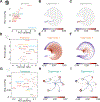The evolutionary trajectory of drosophilid walking
- PMID: 35671756
- PMCID: PMC9329251
- DOI: 10.1016/j.cub.2022.05.039
The evolutionary trajectory of drosophilid walking
Abstract
Neural circuits must both execute the behavioral repertoire of individuals and account for behavioral variation across species. Understanding how this variation emerges over evolutionary time requires large-scale phylogenetic comparisons of behavioral repertoires. Here, we describe the evolution of walking in fruit flies by capturing high-resolution, unconstrained movement from 13 species and 15 strains of drosophilids. We find that walking can be captured in a universal behavior space, the structure of which is evolutionarily conserved. However, the occurrence of and transitions between specific movements have evolved rapidly, resulting in repeated convergent evolution in the temporal structure of locomotion. Moreover, a meta-analysis demonstrates that many behaviors evolve more rapidly than other traits. Thus, the architecture and physiology of locomotor circuits can execute precise individual movements in one species and simultaneously support rapid evolutionary changes in the temporal ordering of these modular elements across clades.
Keywords: Drosophila; TREBLE; animal behavior; behavioral evolution; ethology; locomotion; phylogenetics.
Copyright © 2022 Elsevier Inc. All rights reserved.
Conflict of interest statement
Declaration of interests The authors declare no competing interests.
Figures







References
-
- Katz (2019). My Word: The conservative bias of life scientists. Current Biology 29, R663–R682. - PubMed
-
- Niepoth N, and Bendesky A (2020). How Natural Genetic Variation Shapes Behavior. Annu Rev Genomics Hum Genet 21, 437–463. - PubMed
-
- Jourjine N, and Hoekstra HE (2021). Expanding evolutionary neuroscience: insights from comparing variation in behavior. Neuron 109, 1084–1099. - PubMed
Publication types
MeSH terms
Associated data
Grants and funding
LinkOut - more resources
Full Text Sources
Molecular Biology Databases

